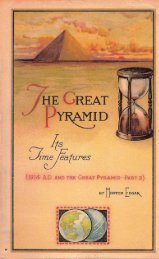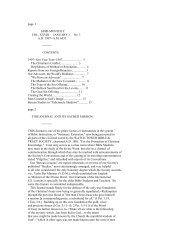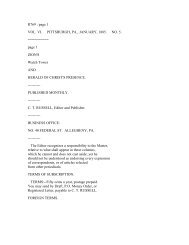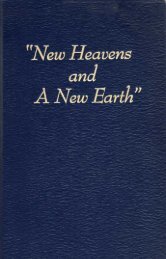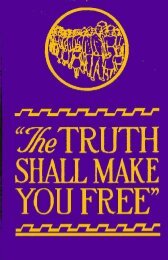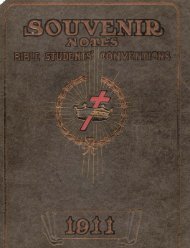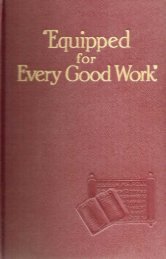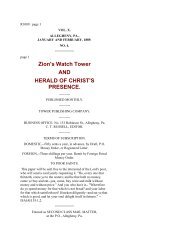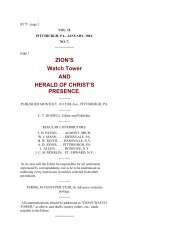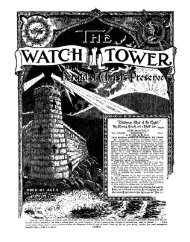The Watchtower Society and John and Morton Edgar - A2Z.org
The Watchtower Society and John and Morton Edgar - A2Z.org
The Watchtower Society and John and Morton Edgar - A2Z.org
- No tags were found...
Create successful ePaper yourself
Turn your PDF publications into a flip-book with our unique Google optimized e-Paper software.
GOD'S PLAN OF SALVATIONr IN THE GREAT PYRAMID 303Although we might be attracted to the Great Pyramid morethan to the others because of its greater size <strong>and</strong> the finer workmadipwhich it displays, <strong>and</strong> also because of its most distinctive<strong>and</strong> peculiar arrangement of passageR <strong>and</strong> ventilated chambers,the Scriptures aid us to identify this pyramid as the one erectedunder God's supervision. <strong>The</strong> Lord in His Word refers us directly,although in hidden language, to the Great Pyramid as his"signv <strong>and</strong> "witness" in the l<strong>and</strong> of Egypt (Isa. 19:19-20).Turn to Job 38:47. Here the Lord calls out to Job from thewhirlwind: ''Where waat thou when I laid the foundations ofthe earth? Declare if thou hast underst<strong>and</strong>ing. Who hath laidthe measures thereof, if thou knowest? Or who hath stretchedthe line upon it? Whereupon are the sockets thereof made to sink?Or who laid the corner-stone thereof: when the morning stars sangtogether, <strong>and</strong> all the sons of God shouted for joy?" (Marginalreading). In the sixth verse we see a reference to foundation"sockets," "made to sink." When we examine the foundationsof the Great Pyramid, we find that the stones at the four basecorners were made to sink into corresponding sockets in the rock.(<strong>The</strong>se foundation stones were removed many centuries ago, <strong>and</strong>the sockets in the rock are exposed to view, but are now muchworn <strong>and</strong> dilapidated by the feet of visitors.) None of the otherpyramids throughout Egypt possess such socket foundation-stones.This Scriptural reference to a constructional feature so distinctiveof the Great Pyramid justifies us, therefore, to expect to find inthis pyramid the details of the Lord's plan set forth in symbol.Although the utterance in Job 38 is in reference to the earth, itis obvious that this ia only to screen the true meaning, for theearth has no socket-stones made to sink anywhere, nor has ita corner-stone, at the hying of which the sons of God are said tohave shouted for joy. It is important to notice, however, that anumber of patient investigators, prominent among whom wasProfessor C. Piazzi Smyth, Astronomer Royal for Scotl<strong>and</strong>, havediscovered many distinct <strong>and</strong> wonderf~l analogies between theearth <strong>and</strong> the Great Pyramid, showing that the author of theBible was also the law-girer to the courses of nature; <strong>and</strong> that hecaused the truths of both the Bible <strong>and</strong> science to be incorporatedin the structure of the Pyramid.It is generally agreed to by competent authorities, even thoughthey do not all believe in the Bible as the inspired Word of God,that the Great Pyramid was the first to be built, <strong>and</strong> that theother pyramids are subsequent erections, copies of the great one.This expIains why none of the other pyramids possess an uppersystem of passages <strong>and</strong> chambers; for history tells us that theirbuilders were totally unaware of the existence of the ascendingpassages <strong>and</strong> chambers constructed high up in the masonry oftheir great model. For 3,000 years these were a profound secret.<strong>The</strong>y were, indeed, discovered by accident. It is recorded thatin the year 820 A. D., a Caliph of Bagdad, A1 Mamouo by name,journeyed to Egypt with a company of men,intentuponplunderingthe great treasure supposed to be hidden in the Py~amid. Atthat time the Great Pyramid was encased with beautiful smoothcasingstones (ail of which, along with the headstone, have sincebeen stripped off <strong>and</strong> taken away to build temples <strong>and</strong> houses,excepting only a fen at the bases of the four sides); <strong>and</strong> the entranceof the low narrow descending passage appears to have beenclosed by a pivoted stone door, balanced in such a way that itcould easily be bwung open by one or two men. <strong>The</strong> ancientgeographer Strabo, who lived in the first century B. C., referredto this stone door. He wrote: ['<strong>The</strong> greater (Pyramid) a littleway up one side, has a stone that may be taken out, which beingraised up, there is a sloping passage to the foundations." <strong>The</strong>reis still evidence existing at one of the pyramids of Dashur thatits entrance was originally closed by a stone swingingonside pivots.At the time of A1 Mamoun's expedition, the exact locationof the stone door of the Great Pyramid had become lost, <strong>and</strong>there was only an indistinct tradition to the effect that it wassituated on the northern flank. We may well imagine thatA1 RiImoun would search long <strong>and</strong> carefully for this pivoteddoor; but he was evidently unsuccessful. When we rememberthat the entrance of the descending passage is situated at adistance of nearly 50 feet vertically above the ground level; <strong>and</strong>,additionally, when we remember that this door was comparativelysmall, <strong>and</strong> lay among many thous<strong>and</strong>s of stones of similarsize (if the average width of the casing-stones was three <strong>and</strong> ahalf feet, i. e., the width of the entrance passage, about 22,000stones would be required to encase each flank of the mightybuilding), we can realize how hopeless would be the search forthis door without a more certain knowledge of its position thanA1 Mamoun possessed. It would be like trying to find theproverbial "needle in the haystack."It does not astonish us, therefore, to learn that A1 Mamounwas unsuccessful in his search for the entrance to the Pyramid;<strong>and</strong> as he was determined to get the treasure which he was persuadedlay hidden somewhere within that huge bulk, he requiredto force an entry for himself. He chose a pot midway betweenthe ground <strong>and</strong> the entrance (see chart). After penetrating tcpa depth of about 120 feet without making any hopeful discovery,his men were nearly giving up in despair, when, one day, theyheard a noise as if something had fallen in an interior cavity.<strong>The</strong>y immediately worked with renewed energy in the directionindicated by the noise, <strong>and</strong> soon broke into the descendingpassage a little below the junction of the first ascending passage.<strong>The</strong>re they saw a peculiar angular-shaped stone lying on thefloor of the descending passage. On examining the roof theysaw an opening from which, evidently, the stone had fallen,thus causing the noise. It was this stone, fitted in flwh withthe general line of the roof of the descending passage, which hadfor so long effectually concealed the lower opening of the firstascending passage. <strong>The</strong> ancient Egyptians, Grecians <strong>and</strong>Romans, when creeping down this low <strong>and</strong> very steep passage*had never thought for a moment that, at a certain spot abovetheir heads, there was a stone, which, with a little forcing, couldbe dislodged from its setting <strong>and</strong> reveal the entrance to a mostwonderful upper system of passages <strong>and</strong> chambers. Had itnot been for a jarring caused by A1 Marnoun's men, forcingtheir way through the masonry a short distance to the west (forthe plane of the Pyramid's passages lies about 24 feet to the eastof the central line of the building), <strong>and</strong> thus causing the stoneto loosen <strong>and</strong> fall, it is probable that the Pyramid's great secretsystem would have remained sealed many centuries longer.We believe, nevertheless, that the entrance of the first ascendingpassage would have been discovered by a more scientificmethod than forcing, when, in due time, the right man, imbuedwith a conriction that the great stone edifice was of more thar?human origin, visited the Pyramid <strong>and</strong> began a careful investigationof every accessible part of the building.When Professor C. Piaezi Smyth, during his extensive operationsat the Great Pyramid in 1865, was measuring in thedescending passage, he noticed that the portion of the floorimmediately underneath the ascending passage entrance isexceedingly hard, so that he could barely make a mark upon itwith a steel tool. <strong>The</strong> soft nature of the remainder of the flooris evident by its worn, dilapidated condition, contrasting greatlywith the smooth appearance of the hard portion, the surface ofwhich is only slightly hollowed by the traffic of centuries. Belowthis hard part of the floor, the passage is bored through thenatural rock which is comparatively soft. Professor Smythnoticed, additionally, that the joints between the stones of thehard portion are diagonal, whereas the joints between all theother floor-stones run square across the passage.This hard part of the descending passage floor with its uniquediagonal joints, is situated so conspicuously opposite the entranceof the first ascending passage that, Professor C. Piazzi Symthrightly judged, it must sooner or later have served as a "pointer"to that entrance, had the concealing roof-stone not prematurallyfallen out as a result of the work of Al Mamoun's men.If it should seem incredible that the entrance of the firstascending passage could have remained unknown for so long aperiod as 3,000 years, let it be remembered that another importantpart of the Pyramid's system remained secret for over 4,000years, namely, the air-channels of the queen's chamber, theexistence of which was not known till so recently as the year1872. <strong>The</strong> builders had channelled out air-conductors for thischamber similar to those of the king's chamber, but had abruptlystopped their inner ends five inches short of the wall surfaces.Mr. Waynman Dixon's investigation of a crack in the southwall accidently led to their discovery. <strong>The</strong> motive of the buildersin so laboriously constructing two long air-channels which couldnot conduct air because of the incompleted inner ends, is unaccountableon any other grounds than that of symbolism. <strong>The</strong>Great Pyramid st<strong>and</strong>s unique in respects to its oenlilated chambers,for none of the other pyramids are provided with airchannels.Al Mamoun, however, found it impossible to go up this newlydiscovered passage; for immediately behind the dislodged roofstoneis a series of three granite stones, which, unIike the limestoneblock that once concealed them, are wedged into theirplace, <strong>and</strong> can never fall out. <strong>The</strong>se stones are still in position,<strong>and</strong> are known coUectively as the "granite plug." So tightlyis the granite plug fitted that A1 Mamoun soon saw it is withextreme difficulty it could be removed; but as he was determinedto penetrate to the as yet unknown interior of the Pyramid inthe direction indicated by the lower end of the revealed passage,he directed his men to force their way round through the softlimestone to the upper end of the plug. We can picture to ourselvesthe expectation of these men, when, on gaining access tothe passage above <strong>and</strong> making their way (as well as they could)up its steep <strong>and</strong> slippery floor, they began sn eager explorationof the dark mysterious passages <strong>and</strong> chamber^, ~ealed up three




